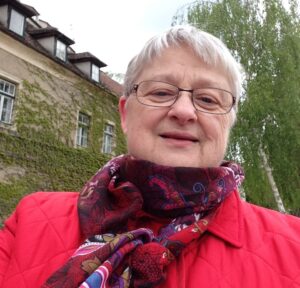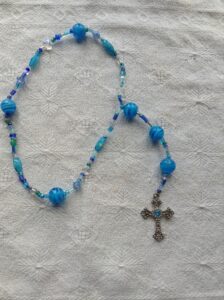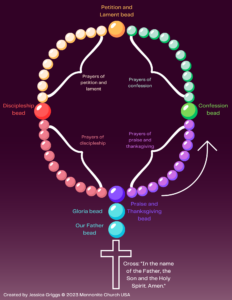 Shirley Yoder Brubaker, a retired pastor and educator, is a member of Park View Mennonite Church in Harrisonburg, Virginia. She and her husband, Kenton, reside at Virginia Mennonite Retirement Community.
Shirley Yoder Brubaker, a retired pastor and educator, is a member of Park View Mennonite Church in Harrisonburg, Virginia. She and her husband, Kenton, reside at Virginia Mennonite Retirement Community.
I have always been intrigued by the devotion that many Catholics give to the rosary. When assigned to do a project for a course on prayer at Eastern Mennonite Seminary some years ago, I decided to make an Anabaptist rosary — perhaps more specifically, a Mennonite rosary. Praying the rosary is basically a mental form of prayer that includes rhythmic repetition of the “Hail Mary,” interspersed with the “Our Father” (the Lord’s Prayer).
I acquainted myself with the Catholic rosary, then the Anglican and, then, the one created by Lois Johns Kaufmann,* a former conference minister with MC USA’s Central District Conference. The number of beads vary. Rather than reciting the “Hail Mary” and “Our Father” to move from one bead to the next, Kaufmann’s rosary uses Scripture. Very Anabaptist. I chose to use songs. Very Mennonite.
Maybe a brief description of the Catholic rosary would be helpful. When using the Catholic rosary, you begin with a cross and two invitational beads. Then you enter the circle of beads: five larger beads, called cruciform beads, each separated by ten smaller beads, called a decade. I was surprised to discover that the Catholic rosary is steeped in the events of Jesus’ life.
While you recite the “Hail Mary” or “Our Father,” you ponder the events in Jesus’ life — the joyful mysteries, the sorrowful mysteries and the glorious mysteries.

Shirley’s prayer beads. Photo provided by Shirley Yoder Brubaker.
For my prayer beads, I decided to keep the traditional opening — a cross and two invitational beads. While holding the cross, I first acknowledge God’s presence by reciting “In the name of the Father, the Son and the Holy Spirit.” On the first invitational bead, I sing “Our Father,” and on the second, the “Gloria.”
After the cross and the first two beads, I begin the circle of beads with a bead I call “the praise and thanksgiving bead.” I sing “Christ we do all adore thee,” and then pause to pray my praises and thanksgivings, as I move to the right, fingering the smaller beads. At the next large bead, “the confession bead,” I sing “Create in me a clean heart” — usually just the refrain — followed by “Kyrie eleison,” as a response to my confessions. The next beads — “petition and lament” and then “discipleship” — each follow the same format. At the final bead, as I exit the circle, I sing a song of benediction, “Come and fill our hearts with your peace.” The “Gloria” and “Our Father” beads are a reprise of the beginning.
The songs can be sung as frequently as wished in each decade of prayers. I hope the memorized songs come to my mind frequently as part of my “praying without ceasing.”
I find that praying with beads slows down the thoughts racing through my head, and my mind is freed to move into a more meditative state. Beads involve our senses of touch and sight. One writer suggested that, with our fingers busy, our minds are open to ponder the deeper mysteries of God. Repeated use brings richness to prayer life. For me, the prayer beads help give shape to my prayers, so I avoid praying only for myself, friends and my pet issues.
I used these beads for a number of months, and then, somehow they got forgotten. Occasionally I find them again in some drawer and use them, but I have yet to use them again daily.
What would I do differently? I would attempt to become more skillful at beading. My work is elementary. And it’s too color coordinated. But most importantly, I would insert a “wild bead” somewhere in the rosary to remind myself of the Holy Spirit — always ready to spring up where and when we least expect.
An Anabaptist rosary
Begin by holding the cross and making the sign of the cross.
Cross: “In the name of the Father, the Son and the Holy Spirit. Amen.”
Our Father bead: The Lord’s Prayer
HWB 228 “Our Father” (VT 674)
Gloria bead: The Gloria
HWB 127 “Glory be to the Father” (VT 430)
“Praise and thanksgiving” bead: (1st cruciform bead)
HWB 105 “Christ, we do all adore thee” (VT 138)
“Confession” bead: (2nd cruciform bead)
STS 62 “Create in me a clean heart” (refrain only) (VT 141)
HWB 144 “Kyrie eleison (response)” (VT 147)
“Petition and lament” bead: (3rd cruciform bead)
HWB 348 “O Lord, hear my prayer” (VT 685)
“Discipleship” bead: (4th cruciform bead)
HWB 163 “Obey my voice”
Return to 1st cruciform bead
STJ 59 “Come and fill our hearts with your peace” (VT 52)
Reprise of “Gloria” bead
Reprise of “Our Father” bead
End by making the sign of the cross.
*Editor’s note, March 18, 2023: After further review, the name of the former CDC conference minister who created the Scripture-based rosary has been corrected to Lois Johns Kaufmann with permission from the author. We apologize for any confusion.
Learn more about the Mennonite Spiritual Directors Network at mennosdn.org.
You can find links to the Spiritual Directors Network website and other congregational and ministerial resources on MC USA’s Church Vitality webpage: https://www.mennoniteusa.org/
The views and opinions expressed in this blog belong to the author and are not intended to represent the views of the MC USA Executive Board or staff.
Interested in submitting a blog for Menno Snapshots? Please see our blog guidelines here.



